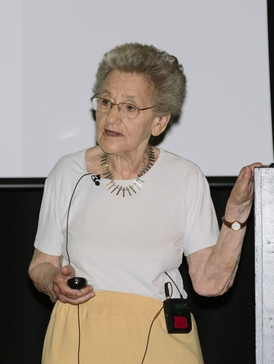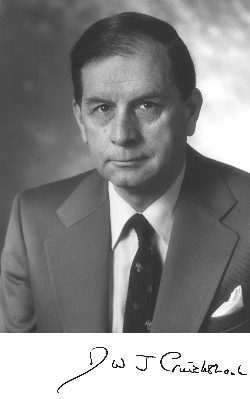
Olga Kennard, Lady Burgen was a Hungarian-born British scientist who specialised in crystallography. She was the founder of the Cambridge Crystallographic Data Centre.

Crystallographic Information File (CIF) is a standard text file format for representing crystallographic information, promulgated by the International Union of Crystallography (IUCr). CIF was developed by the IUCr Working Party on Crystallographic Information in an effort sponsored by the IUCr Commission on Crystallographic Data and the IUCr Commission on Journals. The file format was initially published by Hall, Allen, and Brown and has since been revised, most recently versions 1.1 and 2.0. Full specifications for the format are available at the IUCr website. Many computer programs for molecular viewing are compatible with this format, including Jmol.
Multi-wavelength anomalous diffraction is a technique used in X-ray crystallography that facilitates the determination of the three-dimensional structure of biological macromolecules via solution of the phase problem.
Diffraction topography is a imaging technique based on Bragg diffraction. Diffraction topographic images ("topographies") record the intensity profile of a beam of X-rays diffracted by a crystal. A topography thus represents a two-dimensional spatial intensity mapping (image) of the X-rays diffracted in a specific direction, so regions which diffract substantially will appear brighter than those which do not. This is equivalent to the spatial fine structure of a Laue reflection. Topographs often reveal the irregularities in a non-ideal crystal lattice. X-ray diffraction topography is one variant of X-ray imaging, making use of diffraction contrast rather than absorption contrast which is usually used in radiography and computed tomography (CT). Topography is exploited to a lesser extent with neutrons, and is the same concept as dark field imaging in an electron microscope.
The International Union of Crystallography (IUCr) is an organisation devoted to the international promotion and coordination of the science of crystallography. The IUCr is a member of the International Council for Science (ICSU).

Acta Crystallographica Section A: Foundations and Advances is a peer-reviewed structural science journal published bimonthly by the International Union of Crystallography. It contains papers describing fundamental developments in structural science. It was founded in 1967 when Acta Crystallographica was split into two sections, and was initially titled Acta Crystallographica Section A: Crystal Physics, Diffraction, Theoretical and General Crystallography. The journal's name changed in 1982 to Acta Crystallographica Section A: Foundations of Crystallography. The journal adopted its current title in 2013.

Hydrogenoxalate or hydrogen oxalate(IUPAC name: 2-Hydroxy-2-oxoacetate) is an anion with chemical formula HC2O−4 or HO−C(=O)−CO−2, derived from oxalic acid by the loss of a single proton; or, alternatively, from the oxalate anion C2O2−4 by addition of a proton. The name is also used for any salt containing this anion. Especially in older literature, hydrogenoxalates may also be referred to as bioxalates, acid oxalates, or monobasic oxalates. Hydrogenoxalate is amphoteric, in that it can react both as an acid or a base.
Arthur William Pryor was an Australian physicist known for his contributions to neutron diffraction and infrared laser isotope separation. Pryor authored and co-authored a number of papers in the field of crystallography and he also co-authored, with B. T. M. Willis, the book Thermal Vibrations in Crystallography.

Macromolecular structure validation is the process of evaluating reliability for 3-dimensional atomic models of large biological molecules such as proteins and nucleic acids. These models, which provide 3D coordinates for each atom in the molecule, come from structural biology experiments such as x-ray crystallography or nuclear magnetic resonance (NMR). The validation has three aspects: 1) checking on the validity of the thousands to millions of measurements in the experiment; 2) checking how consistent the atomic model is with those experimental data; and 3) checking consistency of the model with known physical and chemical properties.

Randy John Read is a Wellcome Trust Principal Research Fellow and professor of protein crystallography at the University of Cambridge.
In crystallography, mosaicity is a measure of the spread of crystal plane orientations. A mosaic crystal is an idealized model of an imperfect crystal, imagined to consist of numerous small perfect crystals (crystallites) that are to some extent randomly misoriented. Empirically, mosaicities can be determined by measuring rocking curves. Diffraction by mosaics is described by the Darwin–Hamilton equations.
Quantum crystallography is a branch of crystallography that investigates crystalline materials within the framework of quantum mechanics, with analysis and representation, in position or in momentum space, of quantities like wave function, electron charge and spin density, density matrices and all properties related to them. Like the quantum chemistry, Quantum crystallography involves both experimental and computational work. The theoretical part of quantum crystallography is based on quantum mechanical calculations of atomic/molecular/crystal wave functions, density matrices or density models, used to simulate the electronic structure of a crystalline material. While in quantum chemistry, the experimental works mainly rely on spectroscopy, in quantum crystallography the scattering techniques play the central role, although spectroscopy as well as atomic microscopy are also sources of information.
In 1986 the International Union of Crystallography (IUCr) established the Ewald Prize for outstanding contributions to the science of crystallography. The Ewald Prize is considered the highest prize available to crystallographers apart from the Nobel Prize. The Ewald Prize has been described as prestigious, acclaimed and coveted.

Theo Willem Jan Marie Janssen, better known as Ted Janssen, was a Dutch physicist and Full Professor of Theoretical Physics at the Radboud University Nijmegen. Together with Pim de Wolff and Aloysio Janner, he was one of the founding fathers of N-dimensional superspace approach in crystal structure analysis for the description of quasi periodic crystals and modulated structures. For this work he received the Aminoff Prize of the Royal Swedish Academy of Sciences in 1988 and the Ewald Prize of the International Union of Crystallography in 2014. These achievements were merit of his unique talent, combining a deep knowledge of physics with a rigorous mathematical approach. Their theoretical description of the structure and symmetry of incommensurate crystals using higher dimensional superspace groups also included the quasicrystals that were discovered in 1982 by Dan Schechtman, who received the Nobel Prize in Chemistry in 2011. The Swedish Academy of Sciences explicitly mentioned their work at this occasion.

Durward William John Cruickshank, often known as D. W. J. Cruickshank, was a British crystallographer whose work transformed the precision of determining molecular structures from X-ray crystal structure analysis. He developed the theoretical framework for anisotropic displacement parameters, also known as the thermal ellipsoid, for crystal structure determination in a series of papers published in 1956 in Acta Crystallographica.
This is a timeline of crystallography.
Alexander Frank Wells, or A. F. Wells, was a British chemist and crystallographer. He is known for his work on structural inorganic chemistry, which includes the description and classification of structural motifs, such as the polyhedral coordination environments, in crystals obtained from X-ray crystallography. His work is summarized in a classic reference book, Structural inorganic chemistry, first appeared in 1945 and has since gone through five editions. In addition, his work on crystal structures in terms of nets have been important and inspirational for the field of metal-organic frameworks and related materials.

Symmetry aspects of M. C. Escher's periodic drawings is a book by crystallographer Caroline H. MacGillavry published for the International Union of Crystallography (IUCr) by Oosthoek in 1965. The book analyzes the symmetry of M. C. Escher's colored periodic drawings using the international crystallographic notation.
Norio Kato was a Japanese physicist and crystallographer. He was known for his contributions in diffraction topography and the dynamical theory of diffraction, including the validation of the Pendellösung effect and extensions to account for realistic scattering conditions.








